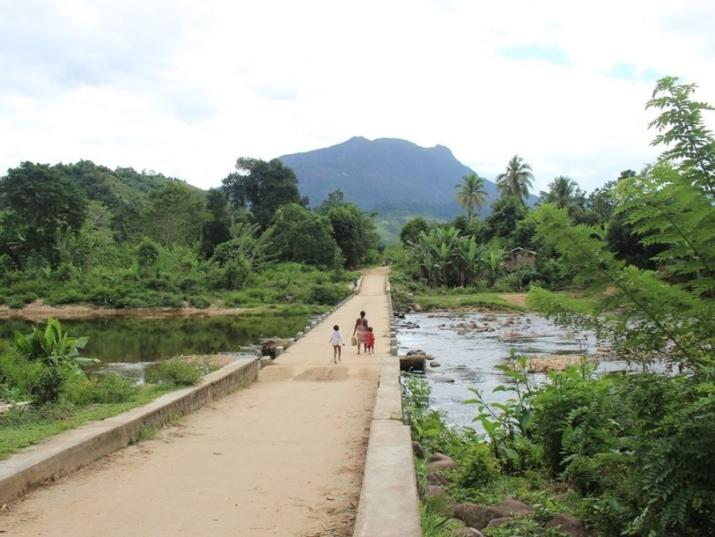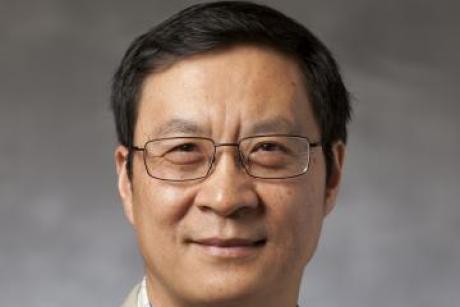
This gorgeous river is sadly the polluted water source for all of Manantenina and Mandena. Most people in the community lack an understanding of bacteria and assume that if the water is clear, it's clean, which often leads to illness.
Published July 27, 2018, last updated on July 30, 2018 under Voices of DGHI
By Helena Merk, rising sophomore, computer science and global health major
The village of Manantenina, Madagascar, a four-day trip from Duke, is as culturally different as geographically distant. The population is slightly above 1,300 people, none of whom have access to basic necessities such as clean water. The main source of income is through the annual vanilla sale and the food staple is rice. As the price of vanilla fluctuates internationally, the community endures cycles of famine. Families frequently take loans to buy food, sell plots of land to afford medical care, and easily slip into cycles of poverty.
For the past nine weeks, I was working in Manantenina with Duke Engineers for International Development and had the pleasure of getting to know countless individuals and the greater community. Through village consultations lasting from sunrise until sunset, I gained a deeper and more nuanced understanding of locals; in addition to lifestyle and challenges, I began to understand people’s priorities, aspirations, and reasoning.
The most difficult realization for me was despite villagers working hard, they rarely try anything new. This mindset was difficult to work with. I’ve grown up in Palo Alto, California, the heart of the Silicon Valley, and I’m accustomed to everyone striving for more; we work for the newer, faster and cheaper solutions to problems. In Manantenina, this sense of urgency was lacking—even though there is suffering, hardly anyone takes action.
The Duke Engineers for International Development team I was traveling with hoped to be catalysts for change. I believe global health, as any other field, can benefit significantly from innovation and ideation. Throughout the academic year, we designed a tap system under the guidance of Dr. David Schaad, with the purpose of the in-country visit being twofold: consultation and project management. When we arrived in Madagascar, though, everything changed.
We arrived with the goal of finishing a tap system for the village of Manantenina. Current residents depend on polluted river water for all of their cooking, drinking, washing, livestock, etc., which only further pollutes the water. This, in combination with a general lack of understanding of what clean water is, has led to many sicknesses¬¬—especially for young children and the elderly.
Through extensive consultation, we learned what questions to ask and, more importantly, how to word them, to elicit the most truthful responses. Nearing the end of our trip, one women even proclaimed, “Yes! Of course people poop in the river. I see poo floating when I do laundry and sometimes I even witness the culprit.” Sadly, the village upriver, Mandena, has even less of an understanding of what clean water is.
As with most international development projects, we ran into issues that we had not prepared for. This resulted in the project significantly changing scope soon after arrival, upon discovering we were working with faulty data. Regretfully, the team that traveled last year failed to take proper measurements, selecting the water source without sufficient community consultation. They preemptively built a dam and a filter box at this unviable source. This year’s group made the mistake of assuming the viability of the source was verified. Yet, we quickly discovered the chosen source was too small, not elevated enough, and polluted by livestock.
How this had continued so far both perplexed and angered us. Eventually, we concluded that it all came down to a lack of communication and a disregard of common source selection procedures. Last year’s team had little to no involvement with source selection, and once the source was chosen, they did not complete proper viability assessments. The landowner of the original source claimed it was sufficient in quantity, elevation and cleanliness. His evaluations were never questioned, despite his lack of expertise in water engineering.
With this realization, our workload changed and grew exponentially. We stopped construction and had to manage contractors that had been promised both a project and money. We had to find a new source and take proper calculations and perform quality testing. We had to communicate effectively with villagers that had been promised clean water this summer.
After many interviews with locals and countless hikes up the rainforest, we found a viable option above Mandena, the village upriver of Manantenina. Since Mandena also lacks clean water access and the source was large enough, we decided to increase the project scope to give both villages taps. This meant agreements were necessary between the two villages and we are tasked with forming and advising a second water committee.
The water network is now designed to serve four times as many individuals. Consequently, this far larger project needs significantly more funds. We spent time creating documents and requests for Malagasy government aid and helped equip the water committees with applying to NGO grants as well. Now that our team is back home, we are writing to U.S.-based NGOs and corporations and seeking other ways to help fund the extended tap system. Before leaving, we established an effective line of communication with the village, found several potential contractors and finalized the government aid request.
Although the scope of the project changed, and the village does not yet have water, we believe a future system that allows for hundreds of clean water taps in both villages is far superior to an immediate system that would maximize at four polluted water taps for a single village.
Through the project, I have learned immensely about communication—across language barriers in villager consultation, but also amongst team members.
To learn how I applied my background in user-centered design to the project, read Part 2, “Lessons in User-Centered Design.”
To learn more about my work with the community, watch my video:

